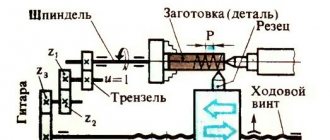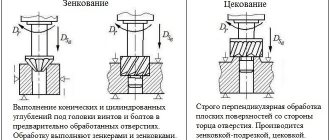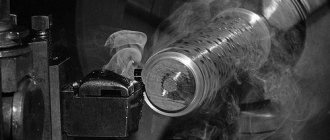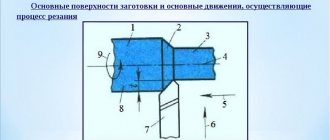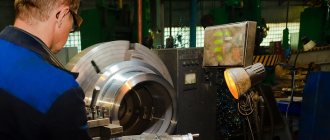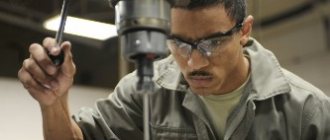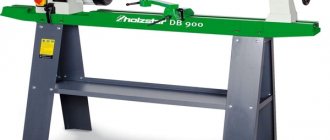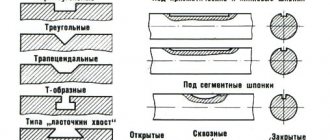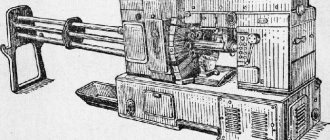The essence of turning is the formation of the surface of a part with a tool with a cutting edge, which, as a rule, rotates the workpiece and moves the cutter. The turning process is quite diverse in the shape and materials of the parts being processed, types of operations, processing conditions, requirements, cost and many other factors. Using roughing and finishing operations performed on CNC lathes, parts of various configurations are obtained with a surface finish Ra of up to 1.25, and in some cases even higher. Surface accuracy depends on the rigidity of the machine-tool-workpiece system, on the tool used and cutting modes: the harder the cutting edge of the tool (hard alloys, metal-ceramics, CBN, cubic boron nitride, diamond, etc.), the higher the rotation speed of the workpiece, the lower feed and overhang of the cutter, the better the surface cleanliness and accuracy.
| TS1625F3 | TS1720F4 |
There are several main types of turning operations, which include:
•processing of cylindrical surfaces;
•processing of conical parts such as shaft;
•design of complex surfaces of bodies of revolution, shaped turning, turning of fillets and roundings
•cutting of workpieces, processing of ledges;
•turning of grooves (external and internal);
•drilling holes;
•boring, reaming, countersinking of holes;
•cutting internal and external threads using cutters and tools: taps, threading heads.
•cutting blanks;
Machining of cylindrical surfaces
is one of the simplest operations for selecting the type of tool, calculating cutting conditions and programming processing.
Turning is a combination of two movements - rotation of the workpiece and movement of the tool. In the case of processing cylindrical surfaces, the tool is fed along the axis of the rotating workpiece, thus removing the metal allowance, that is, processing the diameter of the workpiece. A type of external turning is the processing of stepped shafts using continuous thrust and scoring cutters.
On CNC machines, optimization of the turning process occurs in the direction of increasing speed and the ability to carry out processing with several tools in one setup, which allows both roughing and finishing processing to be carried out in one cycle. It is also important to increase control over the turning process, which ultimately affects the quality of the machined parts and the reliability of the entire operation.
When turning cylindrical surfaces on CNC machines, high turning accuracy is achieved thanks to the rigidity of the system, modern cutting tools and various processing control systems.
To ensure the rigidity of the machine-tool-workpiece system, the following methods of securing the workpiece are used:
1. when processing in a chuck - reducing the overhang of the workpiece (modern lathes have an enlarged hole in the spindle)
2. when processing long and heavy parts - fixation in the centers of the headstock and tailstock. As a rule, a rotating center is inserted into the quill and the workpiece is pressed with it. The drive faceplate transmits torque from the lathe spindle to the product.
2. Fastening parts with a relatively short length in a three- or four-jaw lathe chuck. Long workpieces can also be fixed in the spindle chuck, and their cantilever part is supported by a steady rest during cutting. The steady rest is installed on the guides of the frame or support.
3. Use combined (1 and 2) fastening of the workpieces.
4. Technological methods often include the ability to control the machine spindle at near-resonance frequencies (controlled oscillatory acceleration and deceleration of the spindle).
Effective performance of various turning operations requires the use of specially designed tools. More details about turning tools are described in the article:
The most well-known and widespread machining process control systems include machine tool sensors for monitoring the cutting edge of a tool. Accounting of cutting time for each tool and automatic change to a backup tool.
Turning of conical parts such as shaft
For this type of processing, CNC lathes have an undeniable advantage. Precise and productive turning of the conical surface of a part on universal machines is a labor-intensive operation that requires not only appropriate qualifications of the turner, but also additional devices (use of simultaneous feed along two axes (if technically possible), template, copy ruler). While the CNC machine carries out simultaneous longitudinal and transverse feed of the tool. This allows linear movements along the X and Z axes to be specified in one block when programming processing. In this block of the control program, the coordinates of the end point of the movement - the top of the cutter - are indicated. This programming method is the most universal, as it allows processing with any taper angle. Chamfering is often a standard CNC feature that speeds up the programming process.
Scheme of processing on a lathe
To launch a new series of products at any enterprise, schematic images are developed that play the role of technical specifications for turners. They make it possible to greatly simplify and save time on metal work, since the craftsman does not have to independently select the mode, speed, and required cutter. The circuits are first checked to avoid various defects. This also allows you to calculate more accurate product parameters, which is especially important for serial turning production.
The diagram shows:
- method of fixing the cutter;
- its position in relation to the workpiece;
- turning process using symbols.
It presents the main parameters, which can be adjusted if necessary to achieve maximum precision in processing parts.
Design of complex surfaces of bodies of rotation, shaped turning
To obtain bodies of revolution with a curved generatrix on universal machines, it is necessary to use through or shaped cutters using a copier or a hydrocopying support. Often, such operations require highly qualified turners, and profitability is achieved only with mass production.
Modern CNC lathes have wide technological capabilities. Shaped surfaces are very diverse; their production in many cases is ensured not by the geometry of the tool, but by the form-building movements of the working parts of the machine according to the program. The use of shaped tools for working on CNC machines is extremely rare. Obtaining the full variety of part surface shapes can be achieved through proper design of the processing program. The accuracy of circular and linear interpolation allows for smooth transitions between frames.
This makes it possible to get by with a relatively narrow range of tools when processing various parts. The programmable point of the cutter is either its tip or the center of the rounding at the tip.
On CNC lathes, it is especially effective to use tools with multifaceted non-grinding inserts made of carbide and super-hard materials. They ensure stability of the geometry, the ability to use the maximum power of the machine, increased tool life, and simplify the setup of the machine when the tool wears out. When one of the cutting edges wears out, the plate is rotated, introducing a new edge into the work. The error in the position of the new face usually does not exceed 0.05-0.1 mm and can be easily eliminated using correctors of the CNC system.
Cutting a product or workpiece
is performed by cutting cutters, with the tool moving transversely to the center of the part. Depending on the size of the part, various methods of fixing an almost cut or cut part are used. Tool breakage at the end of cutting is prevented by using supporting rests and reducing the cutter feed (by 45-55%) when approaching the center of the part by half the radius of the workpiece. Small parts fall into a tray, part catcher or are fixed in a turret fixture.
Main types of metal turning work
Modern lathes allow you to perform various transitions with the workpiece, which can be divided into external and internal. External operations change the outer diameter of the workpiece, and internal operations change its internal dimensions. Each of the subsequent turning transitions is determined by the type of cutting tool used and the trajectory of this tool, which ensures metal removal.
In classical external contour turning, a single-edge metal-cutting tool moves axially along the outer surface of the workpiece, removing material and forming various elements: steps, cones, chamfers, etc. These elements are usually machined with a small radial tool feed. Several passes of the cutter are possible until the final diameter values set by the requirements of the drawing are achieved.
The following are considered specific transitions when turning metals:
- Facing is the process of obtaining a smooth, even surface on one of the ends of the workpiece. The face can be produced in one or more passes, depending on the axial depth of cut.
- Grooving, for which the cutter moves with a radial feed, forming a groove whose width corresponds to the width of the tool. Special tools can be used to form grooves of various geometries.
- Cutting off is a transition for which the cutter moves with a radial feed until it reaches the center or inner diameter of the workpiece.
- Cutting external threads, for which a cutter (usually with a pointed end at an angle of 600) is moved in the axial and radial directions, forming a thread on the external surface. The thread can be cut to a specific length and pitch, and several passes may be required to form it.
Internal operations:
- Drilling in which the drill is inserted into the workpiece in the axial direction, producing a hole with a diameter equal to the diameter of the tool.
- Boring, when the diameter of a previously obtained hole is increased. When boring, various internal elements are also obtained - steps, cones, chamfers, etc. Boring is usually done after drilling.
- Reaming - through this transition, as with boring, the existing hole is enlarged. Unlike reaming, this involves removing a minimal amount of material to create a smoother interior surface.
- Cutting internal threads, which is performed with a tap, with its axial feed. A hole is usually drilled into the existing hole, the diameter of which is equal to the diameter of the tap lead.
Metal turning also involves other, specialized transitions that use the rotation of the workpiece.
Drilling, countersinking, reaming holes
The main method of making holes is drilling. Drilling is the process of making cylindrical holes using a metal-cutting tool. Drilling usually precedes operations such as boring or reaming. Processing can be done either in the center of the part (when clamping it in a three-jaw chuck) or with an offset of the center of the hole. Offset (eccentricity) is achieved by fixing the workpiece in a four-jaw lathe chuck or on the headstock faceplate. On a turning center, it is possible to use a driven tool and make holes both on the spindle axis and with an offset along the X axis. When using a radial drive unit, it is possible to process holes located along the X axis.
In a universal machine, the processing tool: countersink, drill, reamer is fixed in the conical hole of the tailstock directly or through a clamping chuck. in CNC machines - in the toolholder position using special cutting blocks and mandrels.
With the development of tools for machining short holes, the sequence of the drilling process and preparation for it undergoes significant changes. Modern tools allow drilling into solid material and do not require preliminary centering of the holes. High surface quality is achieved and, often, there is no need for subsequent finishing of the hole. The use of modern drills with replaceable inserts allows processing at high speeds and large volumes of generated chips, which in CNC machines are washed out of the hole by flows of coolant supplied under a certain pressure through internal channels.
For precision turning, it is necessary to have correct and uniform sharpening of the cutting edges of the drill, perpendicularity of the end of the workpiece to the tool axis, and the absence of burrs and surface irregularities.
Using Renishaw monitoring and setting systems, software in CNC machines allows you to set tool length and diameter compensation parameters and perform breakage detection during machining. The tool feeding in the machine occurs mechanically. The drill ensures a clean surface of the hole Ra 6.3...3.2, a countersink - Ra 2.5, a reamer - Ra 1.25...0.8.
Boring holes
Precise holes, large-diameter stepped holes, and internal grooves can be produced using boring operations. The product is clamped into the headstock chuck and supported by a steady rest (in the case of significant length or weight). In this case, access to the end processed by the boring cutter remains free. The accuracy of boring on a CNC lathe exceeds the accuracy of drilling, and is often ensured by processing technology, cutting tools, lathe experience, systems for fine-tuning cutting tools and the technical condition of the equipment.
Equipment and tools
When familiarizing yourself with the technology of turning work, it is important to pay attention to the equipment used in its implementation. The main equipment of a screw-cutting lathe includes an electric motor with a set of starting capacitors and an emergency protection unit. Auxiliary devices are represented by a lighting lamp, a coolant supply mechanism and an exhaust fan.
The main toolkit of any lathe is a set of cutters used in processing. Most work operations are impossible without such names as:
- Cut-off.
- Walkthroughs.
- Threaded.
- Shaped.
- Scoring, etc.
Please note: According to the existing classification, cutters belong to the main equipment of the machine.
Auxiliary equipment includes drills and additional tools used during drilling operations. The latter are represented by the following names:
- Countersinks and countersinks used to machine the surfaces of the walls and bottoms of holes.
- Reamers that allow you to achieve high precision boring of hole walls.
- Counterbodies used for processing the bottom of sockets and grooves in the original workpieces.
This category also includes taps and dies (with their help, internal or external threads are manually cut).
